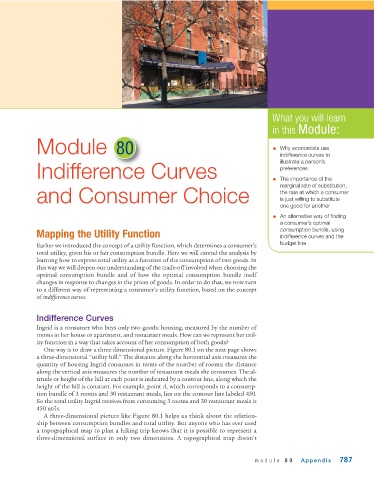Page 829 - Krugmans Economics for AP Text Book_Neat
P. 829
What you will learn
in this Module:
Module 80 • Why economists use
indifference curves to
illustrate a person’s
Indifference Curves preferences
• The importance of the
marginal rate of substitution,
and Consumer Choice the rate at which a consumer
is just willing to substitute
one good for another
• An alternative way of finding
a consumer’s optimal
consumption bundle, using
Mapping the Utility Function indifference curves and the
budget line
Earlier we introduced the concept of a utility function, which determines a consumer’s
total utility, given his or her consumption bundle. Here we will extend the analysis by
learning how to express total utility as a function of the consumption of two goods. In
this way we will deepen our understanding of the trade-off involved when choosing the
optimal consumption bundle and of how the optimal consumption bundle itself
changes in response to changes in the prices of goods. In order to do that, we now turn
to a different way of representing a consumer’s utility function, based on the concept
of indifference curves.
Indifference Curves
Ingrid is a consumer who buys only two goods: housing, measured by the number of
rooms in her house or apartment, and restaurant meals. How can we represent her util-
ity function in a way that takes account of her consumption of both goods?
One way is to draw a three-dimensional picture. Figure 80.1 on the next page shows
a three-dimensional “utility hill.” The distance along the horizontal axis measures the
quantity of housing Ingrid consumes in terms of the number of rooms; the distance
along the vertical axis measures the number of restaurant meals she consumes. The al-
titude or height of the hill at each point is indicated by a contour line, along which the
height of the hill is constant. For example, point A, which corresponds to a consump-
tion bundle of 3 rooms and 30 restaurant meals, lies on the contour line labeled 450.
So the total utility Ingrid receives from consuming 3 rooms and 30 restaurant meals is
450 utils.
A three-dimensional picture like Figure 80.1 helps us think about the relation-
ship between consumption bundles and total utility. But anyone who has ever used
a topographical map to plan a hiking trip knows that it is possible to represent a
three-dimensional surface in only two dimensions. A topographical map doesn’t
module 80 Appendix 787

